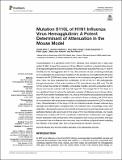Por favor, use este identificador para citar o enlazar a este item:
http://hdl.handle.net/10261/240878COMPARTIR / EXPORTAR:
 SHARE SHARE
 CORE
BASE CORE
BASE
|
|
| Visualizar otros formatos: MARC | Dublin Core | RDF | ORE | MODS | METS | DIDL | DATACITE | |

| Título: | Mutation S110L of H1N1 influenza virus hemagglutinin: A potent determinant of attenuation in the mouse model |
Autor: | Nieto, Amelia; Vasilijevic, Jasmina; Brito Santos, Nuno; Zamarreño, Noelia; López, Pablo; Amorim, Maria Joao; Falcón, Ana | Palabras clave: | Influenza virus HA S110L mutation Attenuation In vivo pathogenicity Viral entry |
Fecha de publicación: | 6-feb-2019 | Editor: | Frontiers Media | Citación: | Frontiers in Immunology 10: 132 (2019) | Resumen: | Characterization of a pandemic 2009 H1N1 influenza virus isolated from a fatal case patient (F-IAV), showed the presence of three different mutations; potential determinants of its high pathogenicity that were located in the polymerase subunits (PB2 A221T and PA D529N) and the hemagglutinin (HA S110L). Recombinant viruses containing individually or in combination the polymerase mutations in the backbone of A/California/04/09 (CAL) showed that PA D529N was clearly involved in the increased pathogenicity of the F-IAV virus. Here, we have evaluated the contribution of HA S110L to F-IAV pathogenicity, through introduction of this point mutation in CAL recombinant virus (HA mut). The HA S110L protein has similar pH stability, comparable mobility, and entry properties both in human and mouse cultured cells that wild type HA. The change HA S110L leads to a non-significant trend to reduce the replication capacity of influenza virus in tissue culture, and HA mut is better neutralized than CAL virus by monoclonal and polyclonal antibodies against HA from CAL strain. In addition, recombinant viruses containing HA S110L alone or in combination with polymerase mutations considerably increased the LD50 in infected mice. Characterization of the lungs of HA mut infected animals showed reduced lung damage and inflammation compared with CAL infected mice. Accordingly, lower virus replication, decreased presence in bronchioli and parenchyma and lower leukocytes and epithelial infected cells were found in the lungs of HA mut-infected animals. Our results indicate that, mutation HA S110L constitutes a determinant of attenuation and suggest that its interaction with components of the respiratory tract mucus and lectins, that play an important role on influenza virus outcome, may constitute a physical barrier impeding the infection of the target cells, thus compromising the infection outcome. | Descripción: | © 2019 Nieto, Vasilijevic, Santos, Zamarreño, López, Amorim and Falcon. | Versión del editor: | http://dx.doi.org/10.3389/fimmu.2019.00132 | URI: | http://hdl.handle.net/10261/240878 | DOI: | 10.3389/fimmu.2019.00132 | Identificadores: | doi: 10.3389/fimmu.2019.00132 issn: 1664-3224 |
| Aparece en las colecciones: | (CNB) Artículos |
Ficheros en este ítem:
| Fichero | Descripción | Tamaño | Formato | |
|---|---|---|---|---|
| Mutation_Nieto_PV_Art2019.pdf | 2,63 MB | Adobe PDF |  Visualizar/Abrir |
CORE Recommender
PubMed Central
Citations
2
checked on 10-abr-2024
SCOPUSTM
Citations
3
checked on 15-abr-2024
WEB OF SCIENCETM
Citations
3
checked on 26-feb-2024
Page view(s)
46
checked on 19-abr-2024
Download(s)
75
checked on 19-abr-2024

